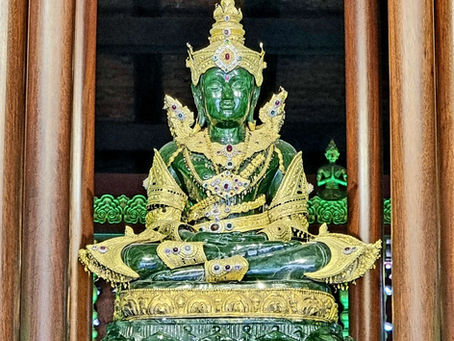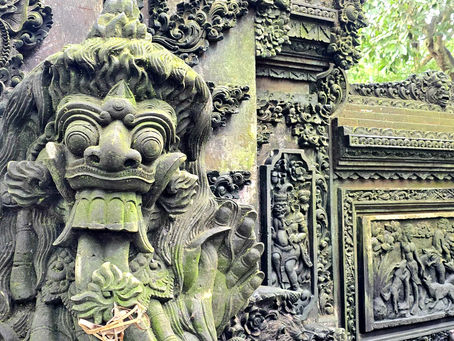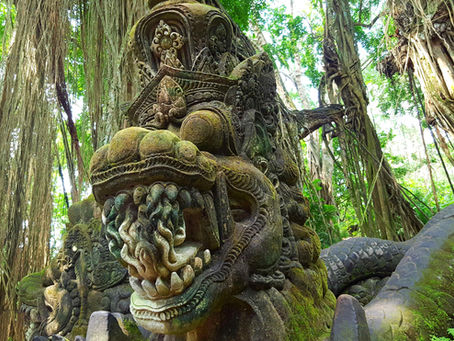top of page

GLOBAL SHANANIGANS

Search


The Royal Regalia Museum of Brunei
The opulent treasures of the Sultan’s legacy are displayed at the Royal Regalia Museum, from glittering crown jewels and ceremonial weapons to life sized gilded carriages and intricately crafted thrones, reflecting the grandeur of royal ceremonies. Heirlooms of faith and power trace the royal family’s lineage to the 14th century, while lavish gifts from world leaders, exquisite Islamic art and rare Qurans highlight the fusion of culture, spirituality and monarchy.
Shannon


Wat Phra Kaew Chiang Rai and The Sacred Storm
Tucked away in the northern Thai city of Chiang Rai, Wat Phra Kaew is a temple steeped in legend, royal heritage and spiritual significance. Once called Wat Pa Yeah or the "Bamboo Forest Temple," it was renamed after its association with the famed Emerald Buddha, now enshrined in Bangkok. Established as a royal temple during the Lanna Kingdom in the late 14th century, it stands as one of Chiang Rai’s oldest religious sites still in operation today.
Shannon


Surat Thani
Long before travellers came seeking ferries to the islands, this land was the heart of the Srivijaya Empire, a kingdom of monks and mariners who spread their beliefs across the seas. While the traces of that empire have mostly faded into dust, Surat Thani still carries its spirit, in the rhythm of daily life, in the gentle pace of its people and in the enduring sense that something sacred once called this place home.
Shannon


Kerta Gosa Pavilion
Steeped in centuries of judgement, where kings and nobles once wielded verdicts beneath the watchful gaze of the gods, Kerta Gosa stands as a chilling testament to Bali’s intertwining of law, ritual and cosmic retribution, a sacred space where punishment was vivid, divine, and absolute. Beneath the flaking frescoes that depict the torments of the underworld, the echoes of those rulings linger like a cold breath, a haunting reminder that justice here was relentless and inescap
Shannon


House of Opium Museum
The House of Opium is a quietly haunting exhibition tucked near the Myanmar border in the sleepy town of Sop Ruak. Since opening, it has served as a solemn guardian of fragile relics and fading memories, preserving antique opium artifacts while recounting the sorrowful story of a trade that scarred generations. The museum casts a sombre light on the human cost of the Golden Triangle’s illicit opium trade, revealing a world of addiction and shattered lives that history too oft
Shannon


Wat Mung Muang
Historical records for this humble temple are scarce, yet local tradition claims it predates the very founding of Chiang Rai, giving it an age of over 800 years. Its origins likely trace back to the early Lanna Kingdom, possibly during the reign of King Mengrai or shortly after. Though modest in scale, Wat Mung Muang has quietly observed the unfolding tides of northern Thailand’s history, standing as a silent guardian of the region’s political and cultural transformations.
Shannon


Tanah Lot - Bali’s Famous Sea Temple
One of Bali’s most revered and iconic sea temples, perched on a rocky outcrop along the island’s west coast, is Tanah Lot. Set about 300 metres offshore, the shrine faces the unyielding tides of the Indian Ocean, its striking presence blending natural drama with deep spiritual meaning. Though calm and picturesque from afar, the temple is regarded as a threshold where divine forces are worshipped and balance is maintained against darker energies.
Shannon


Klungkung Royal Palace
Rising from the legacy of the Gelgel kingdom and the distant glory of the Majapahit Empire, Klungkung Palace was built in 1686 as the proud heart of a fractured Bali. For centuries it stood as a symbol of royal prestige, until 1908, when Dutch fire and a blood soaked Puputan reduced its grandeur to ruin, leaving only whispers of power, betrayal and the ghosts of a kingdom that refused to kneel.
Shannon


Sacred Flames - Ubud’s Cremation Temple
Perched on the shadowed fringe of Ubud’s Sacred Monkey Forest, Pura Prajapati stands as a silent witness to centuries of life, death and the thin veil between them. Built around 1350AD, this moss cloaked cremation temple is one of the forest’s three ancient sanctuaries, yet its presence carries a weight far beyond stone and mortar.
Shannon


Blood and Shadows - Unmasking the Leyak’s Curse
In the dark heart of Balinese folklore, the Leyak is one of the island’s most feared witches but they do not act alone. They serve Rangda, the merciless queen of black magic, whose monstrous face and pitiless power embody Bali’s deepest terrors.
Shannon


The Telaga Waja River
The Telaga Waja River, flowing down the verdant slopes of Mount Agung in East Bali, is best known today for its rafting adventures but beneath its rushing waters lies a deep, often overlooked historical and cultural undercurrent. Historically, this river has served as both a geographical and spiritual artery for the people of Karangasem. It provides water for rice fields through a traditional irrigation system called subak and many Balinese believe it to be sacred.
Shannon


The Great Temple of Death
Agung Padangtegal Temple is one of the primary temples located within the Sacred Monkey Forest Sanctuary in Ubud, Bali. Established in the late 14th century, the temple serves as a key spiritual site for the local community, dedicated primarily to the worship of Hindu deities and various ancestral spirits. It is considered the main temple of the forest complex and plays a central role in religious ceremonies.
Shannon


Goa Gajah Temple
Mystery surrounds the true origins of Goa Gajah, a 9th century cave temple complex near Ubud in central Bali. Rediscovered by Dutch archaeologists in 1923 after centuries hidden beneath dense vegetation, the site holds no actual link to elephants, despite its name. The term “Elephant Cave” likely evolved from Lwa Gajah, an old name associated with the nearby river, not from any animal symbolism found within the temple itself.
Shannon


The Sacred Nāgas of Bali - Guardians of the Island
In the mystical landscape of Bali, where volcanoes brood above emerald rice terraces and the sea whispers ancient secrets, serpentine beings known as Nāgas hold a revered place in the island’s cosmology. These mythical serpent deities, often depicted as long, dragon-like creatures adorned with golden crowns and shimmering scales of green and gold, are considered powerful protectors of water, fertility and the spiritual balance between the underworld, earth and the heavens.
Shannon


In the Shadow of Agung - Sidemen’s Sacred Legacy
Tucked into the emerald folds of eastern Bali, Sidemen is a village preserved in time, its quiet beauty masking layers of history, mysticism & ancient power. Long before it became a retreat for travellers, Sidemen was the cradle of sacred agricultural rituals & spiritual learning. Oral traditions trace the village’s origins back to Bali’s earliest kingdoms, once a training ground for priests drawn to the area's potent energy and its proximity to Mount Agung, the island’s most
Shannon


The Moon of Pejeng - Temple of the Bronze Drum
Pura Penataran Sasih, founded in 1266 AD, was once the state temple of the Pejeng kingdom. Set in the fertile Petauan River valley, it reflects Bali’s ancient ties between ritual and agriculture. At its centre lies the Moon of Pejeng, a 2000 year old bronze drum and the largest single-cast of its kind in the world.
Shannon


Kajeng Rice Fields Loop
Slicing through glittering, gently terraced rice fields and fringed by towering coconut palms, the Kajeng Rice Fields Walk is arguably one of the prettiest treks you can do in the cultural capital of Ubud without a guide. Kajeng offers a rare and intimate glimpse into Bali’s traditional agricultural life, set against a landscape that’s both serene and alive with quiet purpose.
Shannon


The Ogoh Ogoh Museum of Demons
Each March, as Bali prepares for the eerie silence of Nyepi, grotesque effigies of demons and witches are paraded through the streets before being set aflame. Yet not all are consigned to fire, some escape their ritual death and find a resting place in the Ogoh Ogoh Museum, a shadowy graveyard of towering statues where the spirits of chaos seem forever frozen in time.
Shannon


Sangeh Monkey Forest
Sprawled across 14 hectares of ancient forestland, Sangeh Monkey Forest, also known as Obyek Wisata Bukit Sari Sangeh, is one of Bali’s most enchanting natural sanctuaries. Towering nutmeg trees, some reaching over 40 metres tall, dominate the landscape, creating a high green canopy that diffuses the tropical light and hushes the sounds of the outside world. But what truly sets this forest apart is its origin story. According to legend, the trees were not planted, they walked
Shannon


Barong - King of the Good Spirits
Barong is one of the most iconic and revered figures in Balinese mythology, embodying health, good fortune and divine protection. More than just a mythical creature, Barong is believed to act as a guardian angel, accompanying each person through life and shielding them from harm. He is the leader of the hosts of good and the eternal nemesis of Rangda, the dreaded Widow Queen.
Shannon
bottom of page